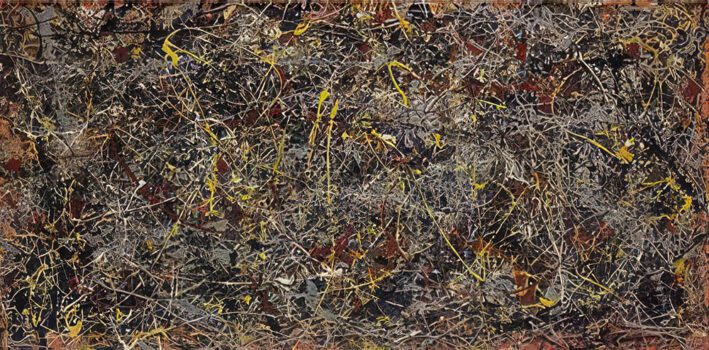Meaning of Jackson Pollock’s No. 5, 1948 Painting
Jackson Pollock’s No. 5, 1948 is more than just a painting; it is a cultural artifact, a defiant statement, a psychological landscape, and one of the most iconic masterpieces of the Abstract Expressionist movement. Often categorized as chaotic, primal, or even nonsensical by those unfamiliar with Pollock’s technique, No. 5, 1948 stands as a hallmark of mid-20th-century modern art, encapsulating the postwar existential anxiety and raw emotion that defined an entire generation. This painting has provoked, puzzled, and captivated viewers and critics alike. But behind the layers of dripping paint lies a rich tapestry of meaning, method, and artistic revolution.
Who Painted No. 5, 1948 and How It Was Created
No. 5, 1948 was painted by American artist Jackson Pollock, a towering figure in the Abstract Expressionist movement. Born in 1912 in Cody, Wyoming, Pollock grew up amid the wide landscapes of the American West, terrain that some say later translated into the vast visual spaces of his paintings.
By the 1940s, Pollock had developed a technique that set him apart from his contemporaries. Influenced by Mexican muralists like David Alfaro Siqueiros and the concept of automatism from Surrealism, he sought to free his subconscious and body into the act of painting. Pollock’s unique contribution to art was the drip technique, which he pioneered in his studio in Springs, East Hampton, Long Island.
For No. 5, 1948, Pollock used a large 4′ x 8′ sheet of fiberboard, a non-traditional surface for painting, laid flat on the ground. Using household enamel paints (not oil or acrylic), he poured, dripped, and flung paint directly onto the surface using sticks, brushes, and even hardened syringes. This method allowed him to walk around and within the painting, integrating his whole body into the process, something he described as being “in” the painting.
Pollock didn’t paint with conscious imagery in mind. His process was intensely physical, almost like a dance or ritual. Each layer of paint interacted with the one before, creating a complex, web-like surface that shimmered with kinetic energy.
What Is No. 5, 1948 All About?
At first glance, No. 5, 1948 may seem like a tangle of disordered lines, a violent storm of color and chaos. But behind that initial impression lies a deeper, layered experience. The painting is a manifestation of pure emotion, psychological introspection, and energy, captured in a frozen moment on canvas. It is not about representation in the traditional sense, there is no subject matter, no landscape, no figure, but it is deeply representational of the human condition.
The painting evokes intense emotional responses because of its chaotic structure and visceral texture. Viewers might see strands of energy, neural pathways, or even bird nests, organic, natural forms that suggest life, birth, and interconnectedness. The palette, muted yellows, browns, grays, and black, conveys a certain somberness, reflecting perhaps the tension of postwar America and the fractured psyche of the time.
Pollock once said, “The painting has a life of its own. I try to let it come through.” That quote encapsulates the essence of No. 5, 1948: it is not about imposing meaning, but about letting the painting unfold like a map of internal thought and subconscious emotion.
Symbolism and Meaning in No. 5, 1948
Although Pollock rejected the idea of symbolism in a traditional sense, saying that he wanted to paint “energy made visible,” many critics and art historians see No. 5, 1948 as a symbolic masterpiece, one that reflects the chaos of the human mind, the existential angst of the postwar period, and even the spiritual struggle for identity.
Chaos and Order: At a glance, No. 5, 1948 appears chaotic. But a closer inspection reveals a delicate balance. The lines cross and weave with a certain rhythm, a hidden geometry. This speaks to the duality of life, chaos always in tension with order.
Psychological Symbolism: Pollock was deeply interested in Jungian psychology and the idea of tapping into the collective unconscious. The web-like structure of the painting can be seen as a visual metaphor for the human mind, complex, tangled, and deeply interconnected.
Spiritual and Mythological Themes: Some interpretations suggest the painting is a modern-day mythological canvas. Like a shamanic trance, Pollock’s process of painting becomes a ritual, a bridge between the conscious and unconscious, the physical and the spiritual.
Existential Representation: Post-World War II, the world grappled with the horrors of war, the atom bomb, and the threat of meaninglessness. No. 5, 1948 captures that emotional dissonance. It is a painting of a world in flux, a mirror to fractured identities and existential fear.
What Is Happening in No. 5, 1948?
Unlike narrative art where scenes and figures play out visibly, No. 5, 1948 presents a non-narrative visual field. But there is something happening, intensely so. The painting is alive with motion. The eye is drawn in multiple directions, pulled by thick and thin lines of paint, speckled with bursts of pigment and interwoven gestures.
One can sense the presence of the artist, his movements encapsulated in every swirl and splatter. Pollock was dubbed “Jack the Dripper” for good reason. His gestures are not random; they are intuitive, instinctual, and filled with intention, even if subconscious. The movement of the paint suggests:
A violent yet purposeful dance;
A stream of consciousness translated into paint;
The trace of time and process, preserved permanently.
Each drip is a record of a decision made in the moment. The painting does not tell a story, but rather presents a state of being, fluid, dynamic, and infinitely interpretable.
What Type of Art is No. 5, 1948?
No. 5, 1948 is a quintessential example of Abstract Expressionism, a movement that emerged in the United States during the 1940s and 1950s. This movement was less concerned with depicting reality and more focused on conveying intense emotion, subconscious thought, and the human experience through abstract forms.
More specifically, Pollock’s work is often classified as Action Painting, a term coined by critic Harold Rosenberg. Action painting emphasizes the physical act of painting as an essential aspect of the finished work. It blurs the line between performance and product, where the canvas becomes a stage and the artist, a performer.
No. 5, 1948 also carries influences from Surrealism (particularly the automatic drawing techniques) and Cubism (its all-over composition). But in the end, it is wholly unique, Pollock invented a new visual language with this piece, one that liberated art from form and narrative altogether.
Where is No. 5, 1948 Painting Today?
No. 5, 1948 is not on public display. It resides in private ownership, making it one of the most elusive and coveted pieces of modern art.
In 2006, No. 5, 1948 became the most expensive painting ever sold at the time, reportedly fetching $140 million in a private sale brokered by art dealer David Geffen. The buyer was later revealed to be David Martinez, a Mexican financier, though this claim has also been disputed.
Because the painting is in a private collection, few have seen it in person, and it exists largely in photographs and reproductions. Despite, or perhaps because of, its inaccessibility, the painting has attained a kind of mythical status, a ghost image of modern art‘s daring transformation.
Jackson Pollock’s No. 5, 1948 is not a painting that offers easy interpretation. It demands time, contemplation, and an openness to feeling rather than understanding. In a world where art often seeks to illustrate or entertain, No. 5, 1948 strips everything down to a raw, primal interaction between artist, material, and space.
Pollock didn’t want to depict the world as it appeared; he wanted to reveal the world as it felt, fractured, intense, fluid, and alive. With No. 5, 1948, he achieved that, producing a work that continues to challenge the way we think about art, expression, and meaning.
Its legacy is not just in its record-breaking price or its abstract elegance. It lies in the freedom it represents, freedom from form, freedom from narrative, freedom to explore the innermost regions of human consciousness on a flat, fibrous surface. In that sense, No. 5, 1948 is not merely a painting; it is an event, a statement, and an experience. And that’s what makes it timeless.




